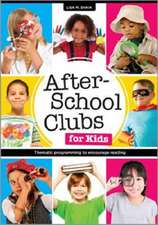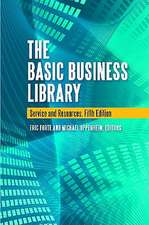From Boardbook to Facebook: Children's Services in an Interactive Age
Autor Adele M. Fasicken Limba Engleză Paperback – 12 iul 2011 – vârsta până la 17 ani
Preț: 291.52 lei
Preț vechi: 337.38 lei
-14% Nou
Puncte Express: 437
Preț estimativ în valută:
55.79€ • 58.03$ • 46.06£
55.79€ • 58.03$ • 46.06£
Carte disponibilă
Livrare economică 25 martie-08 aprilie
Preluare comenzi: 021 569.72.76
Specificații
ISBN-13: 9781598844689
ISBN-10: 1598844687
Pagini: 172
Dimensiuni: 178 x 254 x 13 mm
Greutate: 0.36 kg
Editura: Bloomsbury Publishing
Colecția Libraries Unlimited
Locul publicării:New York, United States
ISBN-10: 1598844687
Pagini: 172
Dimensiuni: 178 x 254 x 13 mm
Greutate: 0.36 kg
Editura: Bloomsbury Publishing
Colecția Libraries Unlimited
Locul publicării:New York, United States
Caracteristici
Illustrations present examples of websites for children's departments and pictures of children's departments
Notă biografică
Adele M. Fasick is professor emerita of the faculty of information studies at University of Toronto, Ontario, Canada, and teaches at San José State University, CA.
Cuprins
CONTENTSPrefaceChapter 1: Children's Services Moving into the FutureAre Libraries for Children Still Important? What Do Libraries as Institutions Offer to Children? What Do Library Services Offer to Children? How Do Today's Children Interact with Media? Barriers to Libraries' Use of Modern Technologies for Children Matching Library Services to Children's Needs SECTION I: CHANGES IN CHILDREN'S LIVESChapter 2: How Have Services to the Youngest Changed?Where Libraries Are Now Programs for Babies and Toddlers Programs for Preschoolers Electronic Enhancements for Programming Bridging the Gap between Home Media and Library Media Using Interactive Media to Facilitate Services Encouraging Ongoing Adult Engagement in Children's Programming Points about Preschoolers Chapter 3: What Has Changed for Children from Five to Nine? Starting School and the Changes That Brings The Difference Reading Makes Learning to Read Practical Value of Reading Changing Media World of School-Age Children Traditional Media New Forms of Media What Does the Proliferation of Media Mean to Libraries? The Disappearing Parent Growing Importance of Peer Group Gender Becomes More Important What Libraries Are Doing for School-Age Children After-School Programs Summer Reading Programs Integrating Library Programs with the Larger Media World After-School Programs Interactivity Is the Key Chapter 4: What's New for 'Tweens and Teens? Digital Natives Heading toward Adulthood Changing Interactions with Technology Effects of Technology Changes Who Needs the Library? No Time for the Library No Interest in the Library No Need for Bricks and Mortar What Libraries Are Doing for 'Tweens and Teens Traditional Programs for Older Children The Big Move-Leaving the Children's Department Patterns of Teen Collections in Libraries Choices for the Location of Teen Collections Keeping Teenagers in the Loop Getting Input from 'Tweens and Teens Responsibilities to Emerging Adults SECTION II: LITERACIES FOR THE 21ST CENTURYChapter 5: Changing Literacies for the 21st CenturyDefinitions of Literacy Importance of Print Literacy Social Advantages of Print Literacy Major Causes of Illiteracy Worldwide Other Factors Limiting the Development of Print Literacy Where Do Libraries Fit In? Providing Print Materials for Non-English Speakers Eliminating Social Barriers to Literacy Working with Other Community Groups Visual and Media Literacy Understanding Pictures in Print Print Images in Different Formats Understanding Digital Images Multicultural Literacy Building a More Multicultural Library Collection Technology and Multicultural Literacy Chapter 6: Developing Information LiteracyHow Do Multiple Literacies Affect Information Seeking? Changes in Collections Changes in Options for Searching Merging Information from Different Formats Library Instruction Formulating Questions and Finding Sources Formulating a Question Locating Sources Evaluating Information Recognizing a Reliable Source-Criteria for Various Formats Collaborative Information Seeking Collaborative Projects for Children Librarians Working on Collaborative Projects Some Basics of Information Literacy SECTION III: BUILDINGS FOR THE FUTUREChapter 7: Changing Library Buildings to Meet Changing NeedsEvolution of Children's Library Departments 1900-1920 1920-1940 1945-Present Factors that Influence Building Design for Children New Forms for Libraries Digital Libraries for Children Hybrid Libraries Looking Ahead to a Seamless Blended Library Chapter 8: Designing a Blended Library Components of a Blended Library Library Portals Secondary Portals-Entrance to the Children's Department What Message Does the Portal Send? Sub-Portals-Access Points within the Library Online Portals How Can the Blended Library Coordinate Its Designs? Online Portals for Mobile Devices Blending Physical and Electronic Media Print and Print-Based Materials Visual Electronic Materials Provision for Face-to-Face Interactions Staffing for Blended Libraries Overview of the Blended Library SECTION IV: PREPARING TO MEET THE FUTUREChapter 9: Preparing for Service in the New Children's LibraryLibrarians as Managers Understanding the Audience Knowing the Community Planning a Program of Services Building Collections Making the Collection Accessible Delivering Information Services Providing Educational and Recreational Programs Forming Partnerships in the Community Evaluating Services Surveys Statistics Observation Marketing the Library's Services Designing a Marketing Plan Being Visible in the Community Using Technology Maintaining Professional Contacts Attending Conferences Working on Committees Keeping in Touch Overview of a Changing Profession Chapter 10: Making Change HappenTaking Stock of What You Have Finding Allies for Change Colleagues Professional Contacts Community Members Starting Change Start with the Easy Steps Maintaining Momentum Maintaining Conditions for Continual Change Setting Up Communications for Marketing Examples of Youth Library Marketing Hearing from Teenagers in San Francisco Blogging for Parents and Younger Children in New Jersey Keeping Colleagues on Board Children and Change References and Further ReadingIndex
Recenzii
This is an essential read for anyone in our profession, and lucky for us Fasick has an inviting, smooth writing style. I enjoyed reading this as much as I do narrative nonfiction-she is clear, to the point, and offers great examples of what she is discussing. Whether you are a youth services librarian who started before we had computers, to those 'digital natives' who are newer librarians, this will have something for you. It is wonderful that Fasick is so positive and optimistic-it is clear the 'death' of the library is just not true, especially if we are able to lead our communities which are already embracing technological innovations.























